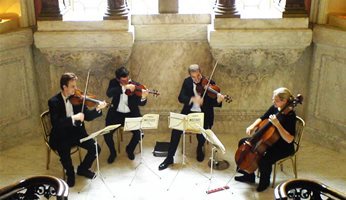I’m not one to malign the general public. Particularly those who come to see me play. But there are very few working musicians carrying an instrument case who can say that they have not at some point been accosted by a (traditionally slightly inebriated) member of the public, be it on the streets, at a bus stop, or even after a concert at which they have been performing, and challenged with
“What’s that, a massive violin or something?”
The inappropriacy of this remark and the extent to which it is an invasion of said musician’s personal space aside, it begs the question – why a violin? Why are string instruments the ones so clearly embedded in our collective conscience? Why do thirties gangsters carry their tommy guns around in violin cases, not drum bags?
A Brief History
Well, one factor might be their age. Although percussion and wind instruments long predate them, the members of the string family have been closest to forms resembling their current states for a very long time, and have seen little need for modernisation since the 1500s. The orchestra, which is I suppose where most people’s minds go when they think of the modern history of music, is full to the brim with string instruments. Whereas even in the fullest symphony orchestra there may be a few percussionists, a row of woodwind and a handful or brass players, there is no limit to the amount of string players that one might see. They epitomise the orchestral sound – they are the ones right at the front of the stage in front of the audience, they are the ones closest to the conductor and most able to react to their directions, they play by far the most notes and they take the majority of the melodies. So critical is the role of the strings in the orchestra that the principal first violin player has a status as individual and legendary as the conductor, and will often walk onstage to an individual round of applause just as they do.
The importance of the character of the solo violinist is key too to their prevalence in the public psyche. The first known virtuoso musicians as we understand them today were violinists, and there is something slightly magical about the instrument. This comes, in part from the fact that it is pretty blooming difficult. Loads of people can sing. Anyone can play the keys on a piano and not have to worry about the tone, and everyone can hit a drum to the desired effect. I would go so far as to say most people had a (hellish) period of time playing wind instruments like the recorder at school. But string instruments? Not only is the way the sound is produced incredibly complex and delicate, but literally requires fine-tuning (and is probably the origin of the phrase) to a ridiculous degree to the point where anyone not at a professional level frankly sounds a bit rubbish. But the pay-off to all this is that you get an instrument that is unrivalled in terms of a balance between its capacity for virtuosic playing, tone production, and the ability to make multiple sounds at the same time. It really is a very special instrument.
Enter Mr Joseph Haydn
The development of the string quartet alongside the orchestra is actually a very simple story, and is down, mostly, to one man, the so-called ‘father of the symphony’ and classical composer 101, Franz Joseph Haydn. The string quartet consists, unsurprisingly (though you would be shocked how many times we get asked this) of four instruments. Two violins – one of whom is the lead player (that all-important principal violin character again, often after whom the string quartet is named), and a second supporting player. One viola – the answer to the opening challenge of ‘What’s that, a massive violin?”…well, yes, yes it is. And one cello – the largest and deepest-sounding of the four. Haydn developed the string quartet (he himself was a virtuoso violin player himself, go figure) as a compact version of the orchestra. The principal violin would of course take the tune and otherwise show off, the second violin would take any counter-melodies, the viola with its middle range of pitch would cover the body of the harmony, and the cello would play the bass, or continuo as it was then called. And, between them, you not only had all the parts of the sound required to get a full picture of the piece of music, but a version that you could fit into a smaller room, and, more importantly, afford.
Perfect for your event
It is the string quartet’s ability fully to realise even the most complex pieces of music that makes them useful today. Yes, they obviously have a rich history of classical repertoire, both religious and secular. But they can play jazz, light entertainment, film scores. And there is absolutely no reason just because you take the vocal away that they can’t play today’s pop music too; look at the resounding success of ‘Vitamin String Quartet’ – despite firmly fitting the aesthetic of Netflix’s Bridgerton series, their pop renditions are instantly recognisable and, frankly, really quite good. The string quartet really does have any number of strings to its bow.
How does this all affect me, I hear you ask. Well, one suspects if you have come to the High Row Music blog, you are looking for an act for your event. There is no act more appropriate for your wedding ceremony, whether the music is religious or secular. There is no act more appropriate for your reception, whether the music is light or jazzy. And there is no act more appropriate as a showcase for later in the day too, playing popular music with dizzying talent.
Claim your orchestra. Check out our string quartet here: https://highrowmusic.com/band/string-quartet/
